By Karla Lant
A Scientific Way of Enhancing Performance?
Futurism curates the products that could help reshape our world. Learn more about Qualia and ‘smart drugs’ here.
Doing research to define what nootropics are is kind of like asking Tekkies which VPN is the best one to use. You get an avalanche of responses from a group of people who are absolute evangelists for the technology, and each is totally sold on their particular solution. This isn’t a criticism; it is the observation of an interested outsider looking in on a movement—the movement to achieve next level humanity.
Nootropics, broadly speaking, are substances that can safely enhance cognitive performance. We’re not talking about convincing your doctor to write you a Ritalin or Adderall prescription to help you stay awake longer. We’re talking about a group of (as yet unclassified) research chemicals, over-the-counter supplements, and a few prescription drugs, taken in various combinations—that are neither addictive nor harmful, and don’t come laden down with side-effects—that are basically meant to improve your brain’s ability to think.
Part of the secret sauce of nootropics is finding the right combination of the right substances, and taking them in the right amounts and proportions at the right times. That series of alignments is your “stack,” and a growing number of Silicon Valley innovators are relying on their stacks every day.
Some nootropics you’ve probably already tried, like fish oil or caffeine, or maybe creatine or L-theanine, an amino acid commonly found in green tea. Others you may not have heard of, substances like the class of about 20 drugs called “racetams.”
To be clear, the idea behind nootropics is not taking a magic pill and transforming yourself into a genius instantly. The core value here is optimization, incremental changes—sometimes tiny ones—that together produce a cumulative effect that is powerful and progressive. Nootropics isn’t like winning the lottery (something that happens all in one day). They are investing; they are cashing in on compound cognitive interest.
In other words, nootropics are not like the pills in Limitless, which make you super-smart instantly. Rather, they pose the seductive question of what you might achieve if you were 10 percent more productive…all the time.
Optimization Neuroscience
Right now, it’s not entirely clear how nootropics as a group work, for several reasons. How effective any one component of a nootropic supplement (or a stack) is depends on many factors, including the neurochemistry of the user, which is connected to genes, mood, sleep patterns, weight, and other characteristics. In other words, results vary, and they can vary a lot.
Second, some nootropic components have received more research attention than others. For example, it is well-known how caffeine affects the body. Unfortunately, as anyone with a coffee habit can tell you, the benefits of caffeine can be lost over time as your body builds up a tolerance to it, and some people experience withdrawal-like symptoms when they don’t ingest caffeine, including headaches.
This is where the amino acid L-theanine comes back into the picture, because research has shown that it reduces physiological and psychological stress responses, making it a great partner for caffeine. It also promotes neuronal health. Studies on the two substances taken together show that they promote alertness, attention, and task switching abilities. This is why the L-theanine and caffeine combination is part of many stacks.
The third factor in ‘where the science behind nootropics stands’ is that many of these substances have been the subject of research studies that proponents don’t think are exactly on point. For example, Kamal Patel points out that Racetams are designed to improve cognitive function, but also notes that researchers aren’t exactly sure what their mechanisms are. According to Patel, this is in part because most research on Piracetam focuses on the elderly and people with real cognitive deficits; in contrast, the people who use nootropics are primarily young professionals who are already at the top of their game (at least, their unenhanced game).
Optimization Neuroscience
Right now, it’s not entirely clear how nootropics as a group work, for several reasons. How effective any one component of a nootropic supplement (or a stack) is depends on many factors, including the neurochemistry of the user, which is connected to genes, mood, sleep patterns, weight, and other characteristics. In other words, results vary, and they can vary a lot.
Second, some nootropic components have received more research attention than others. For example, it is well-known how caffeine affects the body. Unfortunately, as anyone with a coffee habit can tell you, the benefits of caffeine can be lost over time as your body builds up a tolerance to it, and some people experience withdrawal-like symptoms when they don’t ingest caffeine, including headaches.
This is where the amino acid L-theanine comes back into the picture, because research has shown that it reduces physiological and psychological stress responses, making it a great partner for caffeine. It also promotes neuronal health. Studies on the two substances taken together show that they promote alertness, attention, and task switching abilities. This is why the L-theanine and caffeine combination is part of many stacks.
The third factor in ‘where the science behind nootropics stands’ is that many of these substances have been the subject of research studies that proponents don’t think are exactly on point. For example, Kamal Patel points out that Racetams are designed to improve cognitive function, but also notes that researchers aren’t exactly sure what their mechanisms are. According to Patel, this is in part because most research on Piracetam focuses on the elderly and people with real cognitive deficits; in contrast, the people who use nootropics are primarily young professionals who are already at the top of their game (at least, their unenhanced game).
